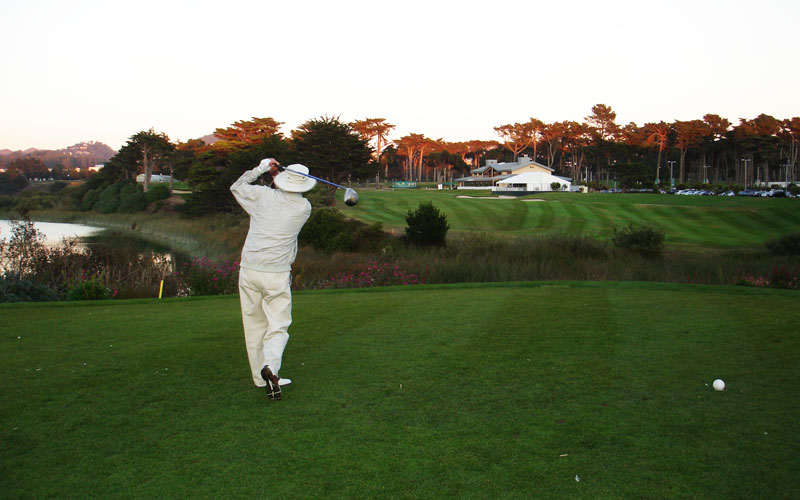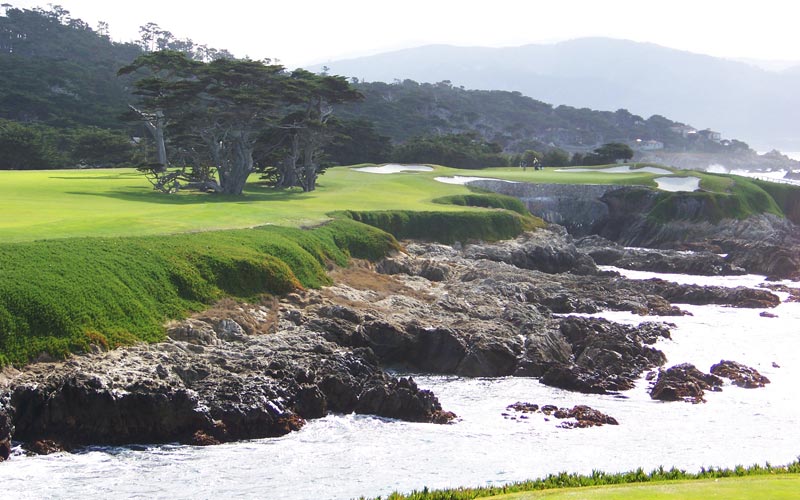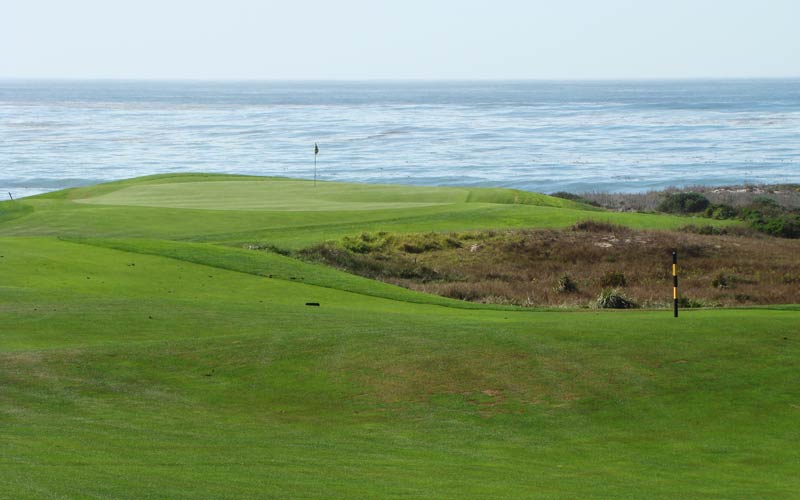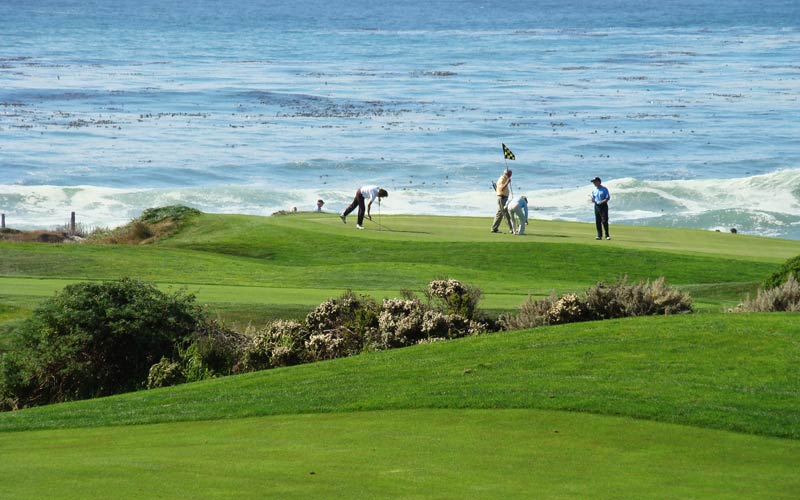Feature Interview with Sandy Tatum Part II
September, 2008

At 88 years of age, Sandy Tatum splits the eighteenth fairway at Harding Park in September, 2008. Playing partners like Harry Easterly saw him do so for decades.
Back to Cypress Point. Have the trees on the seventeenth altered the way the hole should be played?
Not in my view. I’ve been observing and playing Cypress Point since 1936 and I can’t recall those trees growing any higher. The bunkers around those trees have been filled in but the trees have always been there as a very important piece of the landscape and they haven’t altered the hole at all. I first played with Tom Watson in the Crosby in 1978 and the last time exactly 20 years later in 1998 which is now the AT&T. On the 17th, he always kept trying to drive the ball past the trees on the left side. It took me about 5 years to persuade him to hit a 3 iron and 8 iron. It was fascinating to see how the hole affected him.

Has how one should play the seventeenth altered over the years? Perhaps not.
One of your many endeavors and legacy will be the renovation of Harding Park Golf Course in San Francisco. It took many years to finally get it finished and culminated in Tiger Woods defeating John Daly in the American Express golf tournament. What suggestions do you have for municipalities who wish to restore or renovate their golf courses?
The answers to that are in the report by the National Golf Foundation. And what they concluded is that political and other burecratic structures of cities are simply not conducive to effectively maintain, market and manage golf courses. What it also means is that managing and marketing golf courses are a very complicated business and that people who understand and know how to do it should be doing it.
Can municipal golf survive this economic slowdown and sky rocketing expenses especially on the labor side?
Absolutely yes if you get effective professional management and you put the entire economic factors in sensible focus and perspective.
The First Tee program began in 1998. How did you get involved?
It was a remarkable coincidence that at the same time the First Tee program was beginning, I was trying to promote to the USGA executive committee which was then under the leadership of Judy Bell, a similar program which had many of the same factors the First Tee program has. For the First Tee, it’s important to identify the visionaries, and that is the PGA tour. The PGA tour was looking internally at what to do with this game that goes beyond just prize money which is how I was looking at it from the USGA side.
The goal was to attract young people to the game but use it to hook them, so that they wanted to learn to play golf but also to sufficiently get their attention regarding developing core values needed to be decent effective human beings. The program uses golf for that primary purpose.
The PGA tour then went out a received academic input to make sure it was structured effectively and then got the USGA, LPGA, PGA of America and Augusta National on board so the leadership of golf was focused on developing this program.
The influence it’s going to have on the game over a period of time, with cumulatively many kids who are going to be golfers, when the games growth has generally been stagnant. It brings into the game a whole new population with a broad demographic basis.
It’s been an enormous success. We have currently between 1,500 and 1,800 kids enrolled in any one time in San Francisco and cumulatively we will in time effect the lives of many thousands of kids and nationally close to a million kids in 200 chapters across the country which in time multiplies into millions. So now what you have, is a huge program which is not just creating golfers but putting millions of these kids on the right track as effective human beings who will have a real impact on the community. We know that on a statistical basis, 70% of the children and parents interviewed have considered it a success, mainly by changing these children’s behavior and improving their academic performance.
At Harding Park, you incorporated a very successful First Tee program.
If it weren’t for the First Tee, I would have had a different view of the Harding Park project. It added a huge new dimension for me, that the renovation of Harding could offer a perfectly wonderful First Tee chapter facility.
It takes a lot of work, and it’s not a given it will be successful just given a golf facility. The San Francisco chapter has a person, Judith Powell as the program director and she is just an absolute genius in running the program. She really has a connection with the kids, is organized and has a wonderful staff with a whole bunch of volunteers. So you have to have that and you also have to be able to raise the money. You also have to have what I call the fervent commitment to understand how much it matters.
What is an example of a design in the past ten years that lends itself to a fun game with one of your grandchildren?
I can’t think of one.
Let’s go over to England then where the game is still enjoyable for all skill levels. Please discuss Rye Golf Club in England, the President’s Putter and perhaps a memorable match there.
Rye is a winter golf course and I can’t recall ever playing there in the summer. My enthusiasm was derived from Bernard Darwin who was a marvelous writer of the game and he really liked it. It’s a very unusual golf course.
The first time I played in the Presidents Putter was maybe 10 years after I left Oxford and it was unique experience. I played in it maybe 3 times. At the most you had maybe 5 hours of daylight and you had to play two 18 hole rounds in the course of the day. I remember one round which was raining cats and dogs and even though the course drains wonderfully, they had at least 6 or 7 holes cut in depressions on the greens. As a consequence these holes were under about 6 inches of water. They made no provision to deal with it so what you had to do is hit it hard enough to stop the ball on the surface of the water above the water and have it sink down, into the hole. It was typical of the concept they had, namely you went out and played and took the conditions as they were and just did what you had to do to get the ball into the hole.
It is probably a little more serious now but the level of play was very good and the competition was perfect. It was very spirited and yet locked into the values of the game.
A few years later, Herbert Warren Wind went over eventually at my urging and wrote a wonderful piece in the New Yorker regarding it. He got the whole measure of the experience.
Would you rather have won the United States Amateur or the President’s Putter?
That’s a hard one, but in the end the US Amateur.
At Royal Worlington & Newmarket, nine holes is played in under one hour. Members at Swinley Forest enjoy a round holes in less than two and half hours. Why is pace of play on this side of the Atlantic such a problem?
The reason is the intense focus on playing the game by professional golfers. Golfers are seriously influenced by the way professional golfers play the game. Professional golfers are engaged in a game that ordinary golfers don’t have to be in order to play the game.
If you are playing for the love of the game and all the values that are in it, you need to use your time in a constructive way. Wandering around the green, looking at a putt from four different angles is not going to produce a result worth the time involved for the ordinary golfer. We just take too much time over virtually every shot.
We need to focus on moving a little faster, and if we did I think we would substantially reduce the time it takes without diminishing the pleasure we get from playing the game.
What is the your favorite new course built in the last twenty years?
Pacific Dunes and Sand Hills; in a way they are related. No matter how good Bandon Dunes is, Pacific Dunes is a little better.
Regarding Bandon, a few years ago, Golf Digest asked me to go up and write a piece on Bandon Trails, the new Coore/Crenshaw course which was a very interesting project for me. That course was a tough challenge considering they already had two great golf courses there. They pulled it off with one exception. I have a big problem with that artificial 4 par on the back nine. It takes that hole totally out of the context of the course when you add water especially in relationship to that design. I had a really hard time writing about it.
Please discuss your involvement in golf development and architecture.
Sometime in the 1960’s, Sam Morse had retired as CEO of Del Monte Properties and I received a call from his successor of the Pebble Beach Company. He told me that Pebble Beach was hosting the 1972 US Open and asked if I would undertake a renovation project for the company. Pebble had really deteriorated and I was pleased to do it, on a pro-bono basis. For those of us who are avid golfers, to have a chance to work on Pebble Beach was beyond words, wonderful.
Luckily, I was able to enlist Jack Neville who was in his 70’s and living reclusively in Pacific Grove but was perfectly competent. Jack gave me two things I needed for the project, it gave me his perceptions even though it was my project and it gave me the credibility I needed to do what I thought should be done. My observation of Jacks work at Pebble Beach is that he did the best possible routing of that piece of earth and I was thrilled to be involved with him. He was also thrilled to be working again on the course he created.
We started by adding a bunker on the left front side of the green on #1 and then added about 20 yards with new tees on both #2 and #3. The bunkering on #4 had really deteriorated in the drive zone so we renovated that and we established a pot bunker in the elbow. On #6 we really did a lot, we renovated and moved those bunkers in the drive zone but more importantly we reestablished that bunkering on the top of the hill. #9 had a very serious problem because they didn’t irrigate the area on the left side of the fairway, it was just hardpan and if you hit your drive there the ball could run almost up to100 yards from the green. So we established some bunkers there on the left side of the drive zone.
#10 was a very strange hole. The tee on that hole used to be to the right of the ninth green and you would drive across the beach to the fairway which had a small collection of bunkers to deal with on your tee shot. The 10th tee had been moved to the left side of the ninth so those bunkers didn’t make any sense. So we lengthened that hole considerably and we established new bunkering in the drive zone.
The only other thing we did was establish a penal bunker in the drive zone on the right side of the 16th hole.
The 1972 Open turned out to be a huge success with Nicklaus winning and I couldn’t be happier with what we did.
Based on that success, you became all the more involved in architecture?
From there, while working in a very active law practice, I partnered with golf designer Jim Summers who is a very effective and engaging guy, and we designed and built Lockeford Springs in Lodi, the Mt. Shasta resort course in Mt. Shasta and Tierra Oaks in Redding.
I also worked on some minor restoration work, with the most important being the 7th green at San Francisco. I had read that Tillinghast thought it was the best 3 par he had designed and it had been destroyed by some committee who made a mess out of it. Happily there was a picture in the clubhouse which showed the original green but it took me about 10 years to convince the board to let me do it.
A few years later, at the request of the board I worked with Bob Jones (RTJ2) on the 8th green at San Francisco Golf Club which had deteriorated. Then a few years later, Jones called me and said the Pebble Beach Company was finally going to move forward with a new hotel and golf course at Spanish Bay. He said they had promised the job to Jack Nicklaus but he thought that if we teamed up and brought in Tom Watson we might get it. Jones thought we had about a 10% chance of getting it. To my total amazement Jones was able to convince the company to give us the project.
That piece of property had been mined out so that it was a miserable piece of ground. The Pebble Beach Company used it as a cash cow, and whenever they needed money, they would go in there and mine some sand which had a high silicon content and sold it for a premium. It had been mined down to the bedrock.
So we found some material on the property about a half mile away and built a conveyer belt to transfer about a million cubic yards of material into the site and then shaped it. So what you see there, between the hotel and the bay, every single feature was created by us. We laid out the holes like a blank canvas and shaped them.
Would you do anything different at Spanish Bay if given the chance?
In terms of the basic design, absolutely not. I’m perfectly comfortable that we did all we could possibly hope to do with regard to the layout and design of the holes.
We also hoped we could establish fescue on the fairways and bent on the greens and establish flowing fescue on the non-irrigated areas. When we finished working on the irrigated areas and started working on the non- irrigated areas, Marvin Davis who was the owner just stopped us without explanation so we where precluded from planting the flowing fescue in the non-irrigated areas. When that happened, and talk about an aberrational decision, the county of Monterey came out with about six people and designated everything outside the irrigated areas as sensitive. These are the areas we created. So not only could you not play your golf shot, you couldn’t even go in and retrieve your golf ball. The Pebble Beach Company wasn’t willing to take it on legally so the fact that the golf course has survived as a first rate experience is a commentary on the effectiveness of the design because it’s as though those holes have water hazards on each sides of the fairways from the tee to the green.
It was a marvelous experience for me. To do anything with Tom Watson is very special, but to design a golf course with him and Jones was beyond special. It was a challenge because we needed to coalesce three points of view into a cohesive result. In the end the three of us could not have been more pleased at the end result. For Watson, being his first golf course and working with Jones with all the experience he had it was especially useful.

Though the environmentally sensitive areas undermine some of the fun, Spanish Bay is full of classic architectural features like this horizon green that calls for a nervy pitch at the first.

No one can deny the splendid enviroment that golfers enjoy during their round at Spanish Bay. The golfers above are holing out at the seventeenth.
One of your courses, The Preserve, is currently rated among several top hundred polls. Please discuss.
I was involved in that project from the beginning. Peter Stocker had gone to Japan, arranged the financing and put $70 million on the table and walked away with the deed to 22,000 acres.
I was involved in that project from the beginning. Peter Stocker had gone to Japan, arranged the financing and put $70 million on the table and walked away with the deed to 22,000 acres.
The original concept called for three golf courses and a hotel. Peter thought of a Pine Valley type course near the entrance, and a type of resort course around the hacienda and hotel. The last course would be what I call a Cypress Point type course. Ultimately the plan was turned down by the county and they would only allow one golf course and no hotel. So Peter and I took a comprehensive look at the property and concluded that the site where the golf course now sits would be the most appropriate place for a golf course.
We used Mike Poellat for the architectural documents but after Peter was killed in that grotesque accident they felt we had to bring in a bigger name to help sell the property. So they asked me to help recruit Tom Fazio and he agreed. The routing was mine and Tom and his crew completed the course with some input from me.
Let’s talk about some of your peers and what they meant to you. Harry Easterly, with whom you played quite a bit of golf, was a former USGA President and then Executive Director. What did he mean to the game? Do you have a particular favorite story of one of your matches?
He meant a lot to the game and meant a lot to me. When I arrived on the scene in 1972 he was the chairman of the championship committee and happily I was named to that committee. He and I bonded immediately and he added immeasurably to the whole experience for me and was extraordinarily competent and extraordinarily passionate. We played a wonderful lot of golf together. He was one of the most engaging people I have ever had anything to do with.
We were very similar in terms of our golf abilities. Easterly and I carried on warfare on the golf course and those matches appropriately and constructively were the most intense, competitive situations I have ever been in. I can remember one match we were playing at Royal Dornoch. He had hit two marvelous shots onto this green on a 5 par on the backside. I was hitting my 3rd shot from the rough on the left side and chunked it. On my 4th shot I holed it from the rough and Easterly who was standing on the green dropped his putter and looked up to the heaven and yelled “Jesus Christ!” and with that the skies opened up and we had the biggest hail storm I have been in. That is evidence that the golf gods where involved in our matches.
Joe Dey: He continued to be on the USGA scene when I was involved but only periodically. I was much aware of him and he had a very distinctive personality that caused him to stand out in a way that was quite remarkable. About the only thing I can say about Joe which effectively identifies him is that when the PGA was having all of their problems that needed to be sorted out, the guy they selected was Joe and he did it. It was a monumental accomplishment.
P.J. Boatwright: He was wonderful and his involvement with the USGA was another break for me. He also had a distinctive personality and had a profound regard for the game. When I was on the championship committee for 6 years and chairman for 4 years and in charge of the course setups and selections, to have him as a resource was priceless.
Bill Campbell: The ultimate amateur. He has a record that no one else has, including Bobby Jones, if you consider all of the dimensions. He is the quintessential amateur and made a living working and played golf when he could. He was the West Virginia amateur champion 15 times, qualified for the Open something like 16 times, played in Masters something like 15 times. He qualified for the US Amateur something like 37 times and won it once and was runner up in the British Amateur. And he was president of the USGA and captain of the R&A among other things. It’s a unique record.
As a past President, what is your role at the USGA?
We don’t function formally, but we are an advisory committee of past presidents. Some of us do not hesitate to give advice but it’s basically on an individual basis. They don’t take my advice, especially on how far the ball is being hit, but I do like to weigh in, as constructively as I can, none the less.
The End








